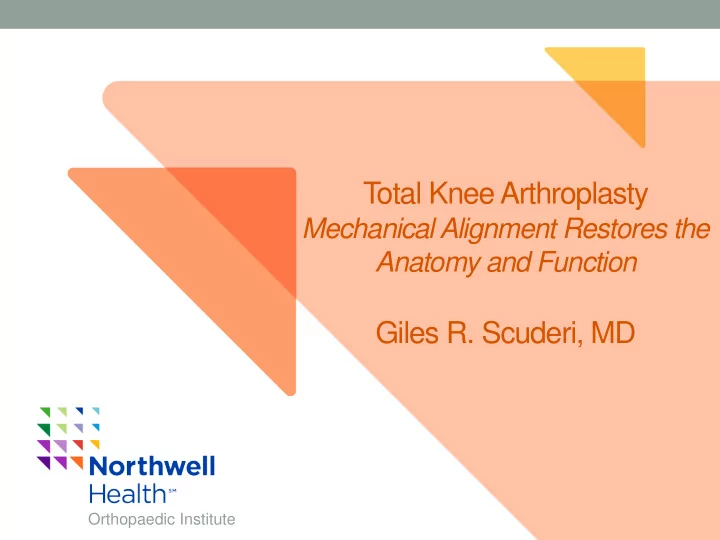

Total Knee Arthroplasty Mechanical Alignment Restores the Anatomy and Function Giles R. Scuderi, MD Orthopaedic Institute
Disclosures Consultant and • Society BOD Royalties • Op Walk USA Zimmer Biomet Book Royalties Consultant Elsevier Medtronic Springer Convatec Thieme Pacira World Scientific Merz Pharmaceuticals Research Support Pacira
The Varus Knee Spectrum of Pathology
The Valgus Knee Spectrum of Pathology
Successful TKA • Long standing surgical principles: • Soft tissue balance • Bone resection • Component alignment • Component fixation
TKA: Surgical Technique Anatomic Resection Classical Resection
Total Knee Arthroplasty • Soft tissue technique • Bone preparation technique • Achieve neutral mechanical axis • Conventional instruments • Computer Navigation • Patient specific instruments (PSI) • Goal • Lower limb alignment should be within 3° of neutral mechanical alignment Berend, et al: CORR 428, 2004 D’Lima, et al: CORR 392, 2001 Fang, et al: J Arthroplasty 24, 2009 Werner, et al: J Biomech 38, 2005 Bellemans: Orthop 34, 2011
Total Knee Arthroplasty Restore mechanical axis • Center hip-knee-ankle • Femur • Mechanical – anatomic angle 6° valgus • Tibia • Mechanical – anatomic angle 0° (neutral) Appropriate Bone Resection Soft tissue balance • Ligament release Patella tracking
Classic Method of Bone Resection
Neutral Mechanical Alignment • Better functional outcome at 1 year when coronal alignment within 3° neutral • International Knee Society Score • SF 12 • Knee Society Score Choong, et al: J Arthroplasty 24, 2009 Longstaff, et al: J Arthoplasty 24, 2009
Alignment and Failure Rate Lower failure rate when restore mechanical alignment Ritter, et al: JBJS 93(A) 17, 2011
Impact of Mal-Alignment • Component mal-alignment in the presence of acceptable knee alignment • Radiographic analysis and retrieval analysis • Tibial component varus • Medial compartment wear • Total wear • Tibial tray subsidence • Varus mal-alignment as low as 3° • associated with accelerated wear, even if overall limb alignment is ideal Srivastava, et al: Knee 19(5), 2011 Collier, et al: JBJS 89A, 2007
Outcome of Total Knee Arthroplasty It’s Not Just the Coronal Alignment • Effect of sagittal alignment • Femur • Tibia • Axial rotation • Femur • Tibia • Soft Tissue Balance
Not Just the Coronal Alignment • Sagittal Position: Risk factors for failure • Flexion of the femoral component >3° • Tibial slope > 7° or < 0° Kim, et al: Int Orthop 38, 2014
Femoral Component Rotation • AP axis to Epicondylar axis: 90.33° ± 2.44° • AP axis to Posterior Condyles: 93.08° ± 2.71° • Epicondylar axis to Posterior Condyles: 3.6° ± 2.02° Poilvache et al: CORR 331, 1996
Correlation Between Condylar Lift-off and Femoral Component Alignment CT scan with fluoroscopic analysis • Supports Epicondylar Axis • Lift-off less frequent • Lift-off of less magnitude Insall, Scuderi et al: CORR 403, 2002 Scuderi, Insall: Am. J. Knee 13, 2000 Olcott, Scott: CORR 367, 1999 Poilvache et al: CORR 331, 1996
Consequence of Internal Rotation of the Femoral Component • Patella instability • Limited Motion • Arthrofibrosis • Lateral flexion laxity • Instability • Less favorable clinical outcomes Romero et al: J. Arthroplasty 22(2), 2007 Boldt et al: Int. Orthop 30(5), 2006
Axial Position of Tibia • Component Malposition • Internal rotation of the tibial component • Causes tibia to externally rotate during flexion • Increases Q-angle
Tibial Component Rotation Matsuda et al: Am. J. Knee Surg: 14(3), 2001
Anatomic Tibial Component • No longer need to sacrifice coverage to get the proper rotation
Combined Femoral and Tibial Rotation Patella Dislocation & Failure Normal Subluxation Tilt Internal External Rotattion Rotattion Berger et al: CORR 356, 1998
Balancing the Knee • TKA is a soft tissue operation • “Every knee has its own soft tissue identity” • Understand the infuence of supporting ligaments • Anterior fibers influence flexion • Posterior fibers influence extension • Release of the PCL with preferentially increase the flexion gap Baldini, Scuderi, et al: J Knee Surg 2004
Soft Tissue Balance in TKA • Every knee has its own soft tissue identity • Deformity may or may not be correctable • Gradual soft tissue release • Goal: Equal and symmetrical flexion and extension gaps
Neutral Mechanical Alignment and Classic Bone Resection remain the Gold Standard • Sufficient supporting data • Clinical and functional outcomes • Durability • Safe Zone • 0° (SD 3°) • Best survival 30 years old
Alignment: Hitting the Target Surgical iASSIST™ Conventional Expertise Instruments
Mechanical vs Anatomic Alignment • Impact of human error in bone resection • Computer navigation outliers • 9% tibiofemoral alignment • 4.9% femoral components • 4% tibial components • Compromises • Aiming for a “slight degree of varus” requires acceptance of 3° of intended varus in addition to potential error of 3° - 4° of varus, resulting in unacceptable alignment. Mason, et al: J Arthroplasty 22, 2007 Abdel, et al: JBJS 96B, 2014 Lombardi, Ortho 34, 2011
“…until additional data can be generated to more accurately determine the ideal post-operative limb alignment in individual patients, a neutral mechanical axis remains a reasonable target and should be considered as the standard for comparison if other alignment targets are introduced…” Parratte, et al: JBJS 92A, 2010
TWO FINAL COMMENTS
Mechanical Alignment • Most Recent Supporting Information • Tibial component varus increased implant migration with lateral liftoff • RSA analysis of cemented PS TKA at minimum of 10 years • In vivo RSA measurement showed greater wear with varus aligned limbs • Despite polyethylene material, retrieval study showed more medial wear • Mechanical alignment still the target • 20 year survival and function • Alternate alignment strategies must prove safety and efficacy MacDonald, et al: The Knee Society Members Meeting, Sept 2017 Naudie: The Knee Society Members Meeting, Sept 2017 Wright, et al: The Knee Society Members Meeting, Sept 2017 Abdel, et al: The Knee Society Members Meeting, Sept 2017
Mechanical Alignment Revision TKA
“THOU SHALL NOT VARUS”
Recommend
More recommend